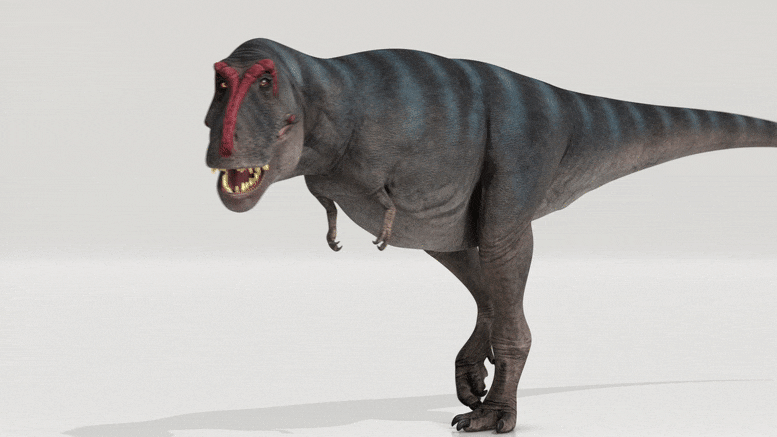

Trix skeleton at the Naturalis Biodiversity Center. Credit: Mike Bink
People and animals have a preferred speed. This is partly influenced by the amount of energy required: it prefers to go at the speed at which it uses the least possible amount of energy. One way to do this is to use something called resonance.
You already know how it works: when you’re in a cradle, you can’t sway at full speed. If you want to do it properly, you have to do the right thing and swing in the swing rhythm. In other words: you have to resonate with him. And when you take a pleasant and relaxing walk, your body parts also resonate. Slightly slower walking does not require less energy: notice that it is actually harder.
An animation of the T.rex Trix gait according to the simulations from Van Bijlert et al. 2021. The tail resonates, allowing a more realistic, slightly slower gait. Credit: Rick Stikkelorum, Arthur Ulmann and Pasha van Bijlert
This works for four-legged animals and for two-legged animals such as humans and ostriches. Pasha van Bijlert, a student of Human Movement Sciences at Vrije University in Amsterdam (VU), applied the idea of an animal that went differently than anything stepping on the ground right now: Tyrannosaurus rex. These carnivorous dinosaurs not only had two legs, but also had an enormous tail that helped them move.

Student Pasha van Bijlert with a replica of Trix, Tyrannosaurus rex which he modeled as part of his thesis. Credit: Tom Brown
Like the bones in the neck, the bones in the tails are held together by ligaments. “You could compare it to a suspension bridge,” Van Bijlert explains. “A suspension bridge with a ton of muscle in it.” At each step the tail swings up and down. This means that, like the cradle, it has a natural frequency at which it resonates.
To find out what this frequency is, Van Bijlert and his professors Anne Schulp (Naturalis / Utrecht University) and Knoek van Soest (VU) built a 3D model of the Trix, Tyrannosaurus rex on display at the Dutch National Museum of Natural History, Naturalis. They added digital muscles to the famous skeleton, and on this muscle model they were able to perform biomechanical analyzes. From these, they derived the natural frequency and a preferred speed: 4.6 km / h (2.9 mph). So when Trix was walking, she was going at about the same speed as you. If you had a T. rex pet, you wouldn’t have any problems walking – at least in terms of speed.
Van Bijlert, Van Soest and Schulp published their findings in the journal Royal Society Open Science today (April 21, 2021). “There have already been some studies that investigated the speed of dinosaurs, but they mostly looked at the legs and ignored the tail – which makes the dinosaurs so unique,” says Van Bijlert. “They usually found much faster speeds. The one I calculated is smaller, but it is similar to that of other animals. ”
Reference: ‘Natural frequency method: estimation of the preferred travel speed of Tyrannosaurus rex based on the natural frequency of the tail ”by Pasha A. van Bijlert, AJ“ Knoek ”van Soest and Anne S. Schulp, 21 April 2021, Royal Society Open Science.
DOI: 10.1098 / rsos.201441